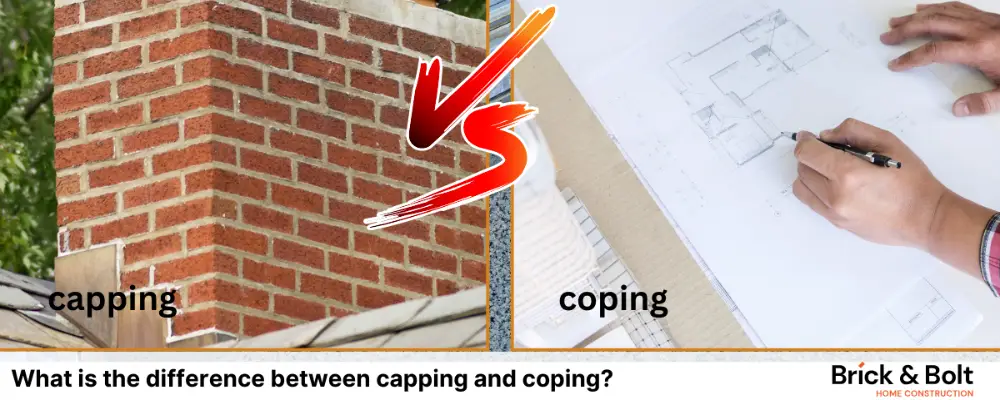In construction, you might hear about “capping” and “coping” when discussing the tops of walls, roofs, and other structures. While they might sound similar, they have different purposes and designs. Let’s dive into what each one is and how they differ.
What is Capping?
Capping can be defined as a layer of protection at the top of a wall or roof that prevents the seeping of water. It acts like putting a hat on the structure for protection against weather conditions, such as rain, snow, and especially the sun. Most often, capping is manufactured from metals, stones, and concretes, which are all strong.
- Purpose: Capping prevents water from seeping through the wall or roof. Water that could penetrate would create deterioration in time, resulting in fissures with possible mold development.
- Material: The common materials employed for capping are metal, stone, and concrete. These materials have been selected because they can withstand harsh weather conditions.
- Appearance: The capping usually looks like a flat or slightly inclined surface on top of a wall or roof. It is functional but can also add some decorative touch to improve the building’s appearance.
What is Coping?
While copping essentially means capping, it is different, as it was designed specifically to cover the top of walls, mostly exteriors. It serves to protect the wall from water and to give the finished look. Coping can be seen on garden walls, parapet walls- the small walls that extend above the roofline- and even on top of fences.
- Purpose: Just like capping, coping protects the walls from water and gives the wall a neat, finished look.
- Materials: Coping can be made from many available materials, such as brick, stone, or concrete. Certain types of coping also have a sloped or rounded top to facilitate the easy runoff of water.
- Appearance: Coping is generally more aesthetic when compared to capping. Coping can be of different shapes-flat, round, and at times pointed. These can be of a simple design or very elaborate depending on the building style.
Key Differences Between Capping and Coping
| Differences | Capping | Coping |
| Purpose | This is done mainly to save the structure from water and weather damage. It is used on both walls and roofs. | It protects the wall from water along with concerning about finishing the top of the wall with a decorative touch. |
| Location | Can be used on both roofs and walls mainly to prevent water infiltration. | Specifically used on the tops of walls, particularly exterior walls, to protect them and improve their appearance. |
| Design and Look | Generally more functional and less decorative; it is about protection. | More decorative, with various styles available to match the building’s design. |
| Materials | Usually made of metal, stone, or concrete. | These are often made from brick, stone, or concrete but with more design options. |
Why Capping and Coping are so Important?
Capping and coping are very important in protecting structures from the water and weather elements. Without it, exposed walls and roofs would be subject to rain and snow, as well as sunlight, which may cause cracks, erosion, and other types of damage through time. They also help maintain both the structural integrity and good appearance of a building.
Capping and coping are most important in those areas that have extreme and bad weather conditions. They keep the water outside, and that is one of the things that catch long-term damage and expensive repairs. Besides, coping gives a finish to the walls for them to look appealing and not just functional.
When to Use Capping and When to Use Coping?
- Capping: For capping, one needs to protect the top of a roof or wall area from water. That is mainly useful in flat or slightly sloped surfaces where the water may collect.
- Coping: Laying copings at the top of external walls, for example, garden and parapet walls, is the best choice when one wants to protect the wall and simultaneously provide an added look to it.
How to Choose Between Capping and Coping?
Location, material, and the desired look are important considerations when people try to decide between capping and coping. If the flat surface – a roof is primarily to be protected, then capping is the perfect one. But if one is finishing the top of an exterior wall and wishes it to look nice, coping is the better option.
Another thing is your area’s weather conditions. If you are staying in an area where heavy rain or snow is frequent, then you would need something durable enough to hold everything together. Both capping and coping could be made from strong materials, but coping offers more design flexibility.
Conclusion
In simple terms, capping and coping are two techniques used in construction that help the walls and roofs from being damaged due to weather conditions. While capping is functional and mainly deals with protection, coping helps give an artistic touch to the structure.
FAQ
Capping protects the top of walls or roofs from water and weather damage. It’s commonly made from durable materials like metal, stone, or concrete. Capping also helps maintain the structural integrity of the building by preventing long-term deterioration.
Coping is more decorative and used mainly on exterior walls, while capping is primarily functional and focused on protection. Coping can come in various styles, like flat, rounded, or pointed shapes. It adds a finished look to walls, enhancing the overall appearance of the structure.
Use coping for exterior walls when you want both protection and a decorative finish. It’s ideal for garden or parapet walls, providing an elegant look while safeguarding against water damage. Coping offers more design flexibility, allowing you to match the building’s style.

